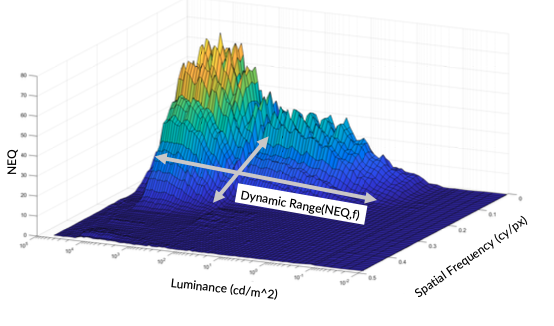
This paper investigates the application of Noise Equivalent Quanta (NEQ) as a comprehensive metric for assessing dynamic range in imaging systems. Building on previous work that demonstrated NEQ’s utility in characterizing noise and resolution trade-offs in imaging systems using the Dead Leaves technique, this study seeks to validate the use of NEQ for dynamic range characterization, especially in high-dynamic-range (HDR) systems where conventional metrics may fall short. This paper makes use of previous work that showed the possibility to measure noise and NEQ on the dead leaves pattern which is otherwise typically used for the measurement of the loss of low contrast fine details, also called texture loss. This shall now be used to improve the measurement of the dynamic range.

Imaging system performance measures and Image Quality Metrics (IQM) are reviewed from a systems engineering perspective, focusing on spatial quality of still image capture systems. We classify IQMs broadly as: Computational IQMs (CP-IQM), Multivariate Formalism IQMs (MF-IQM), Image Fidelity Metrics (IF-IQM), and Signal Transfer Visual IQMs (STV-IQM). Comparison of each genre finds STV-IQMs well suited for capture system quality evaluation: they incorporate performance measures relevant to optical systems design, such as Modulation Transfer Function (MTF) and Noise-Power Spectrum (NPS); their bottom-up, modular approach enables system components to be optimized separately. We suggest that correlation between STV-IQMs and observer quality scores is limited by three factors: current MTF and NPS measures do not characterize scene-dependent performance introduced by imaging system non-linearities; contrast sensitivity models employed do not account for contextual masking effects; cognitive factors are not considered. We hypothesize that implementation of scene and process-dependent MTF (SPD-MTF) and NPS (SPD-NPS) measures should mitigate errors originating from scene dependent system performance. Further, we propose implementation of contextual contrast detection and discrimination models to better represent low-level visual performance in image quality analysis. Finally, we discuss image quality optimization functions that may potentially close the gap between contrast detection/discrimination and quality.